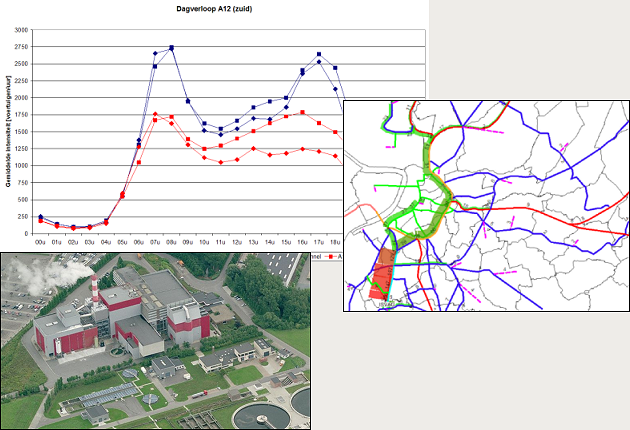The future of ISVAG
09.10 / 16041 / 22041
From 2009 to 2023
ISVAG wanted to assess the current status of the Wilrijk waste incineration plant and explore possible future scenarios. TML assisted the consortium on traffic engineering.
The intermunicipal cooperation ISVAG (Intercommunale voor Slib- en Vuilverwijdering van Antwerpse Gemeenten) in Wilrijk started a study on how it can continue to fulfil its social mission, i.e. the processing of waste from its constituent municipalities, after 1 September 2011 (when its environmental licence will expire).
In order for ISVAG's Board of Directors to make a final decision in this regard, this study drew up the current status of the waste incineration plant. Several possible future scenarios were explored, with some scenarios being worked out in detail in consultation with the client.
The study started from different angles, namely technological, ecological and energy performance, financial-economic, legal, logistics, and transport. These were each dealt with by specialists in their own field, with TML assisting the consortium of companies in traffic engineering.
The study consisted of four consecutive phases:
It resulted in the following preferred alternative: continuing until at least 2023, combined with - in the short term - the implementation of all suggested optimisations, with a licence running until 2031, including the implementation of a new evaluation before 2023 (e.g. 2018).
Update: in a press release dated 20/07/2010, ISVAG announced that it was opting for an extension period of only 10 years instead of our proposed 20 years. Political and social factors are given as reasons for this. By imposing this restriction in permit term, ISVAG has to include a number of evaluation moments. In addition, it needs to always remain alert to stay on top of the best available technology and respond to new developments in the waste management sector.
Update (October 2016): an additional site and mobility study (conducted by TML and the UA) mapped the impact of ISVAG emissions on the environment. In addition, a route study for the construction of a heat network was prepared by other researchers, the current best available technology was scrutinised, and the economic feasibility of a possible new plant was tested. In the process, TML also carried out an update of the mobility analysis.
Update (February 2023): TML conducted another update of the mobility analysis, based on 2022 figures. This showed that no available site scores better, both from an ecological and economic point of view. For this, we examined 18 different sites and found that the current location is the best accessible. (This report is available and can be requested from ISVAG: [email protected]).
The intermunicipal cooperation ISVAG (Intercommunale voor Slib- en Vuilverwijdering van Antwerpse Gemeenten) in Wilrijk started a study on how it can continue to fulfil its social mission, i.e. the processing of waste from its constituent municipalities, after 1 September 2011 (when its environmental licence will expire).
In order for ISVAG's Board of Directors to make a final decision in this regard, this study drew up the current status of the waste incineration plant. Several possible future scenarios were explored, with some scenarios being worked out in detail in consultation with the client.
The study started from different angles, namely technological, ecological and energy performance, financial-economic, legal, logistics, and transport. These were each dealt with by specialists in their own field, with TML assisting the consortium of companies in traffic engineering.
The study consisted of four consecutive phases:
- Phase 1: qualitative definition of all possible alternatives.
- Phase 2: selection of certain alternatives by the Board of Directors.
- Phase 3: detailed quantitative study of the selected alternatives.
- Phase 4: support of the decision-making process by the Board of Directors.
It resulted in the following preferred alternative: continuing until at least 2023, combined with - in the short term - the implementation of all suggested optimisations, with a licence running until 2031, including the implementation of a new evaluation before 2023 (e.g. 2018).
Update: in a press release dated 20/07/2010, ISVAG announced that it was opting for an extension period of only 10 years instead of our proposed 20 years. Political and social factors are given as reasons for this. By imposing this restriction in permit term, ISVAG has to include a number of evaluation moments. In addition, it needs to always remain alert to stay on top of the best available technology and respond to new developments in the waste management sector.
Update (October 2016): an additional site and mobility study (conducted by TML and the UA) mapped the impact of ISVAG emissions on the environment. In addition, a route study for the construction of a heat network was prepared by other researchers, the current best available technology was scrutinised, and the economic feasibility of a possible new plant was tested. In the process, TML also carried out an update of the mobility analysis.
Update (February 2023): TML conducted another update of the mobility analysis, based on 2022 figures. This showed that no available site scores better, both from an ecological and economic point of view. For this, we examined 18 different sites and found that the current location is the best accessible. (This report is available and can be requested from ISVAG: [email protected]).


